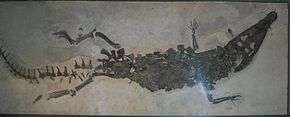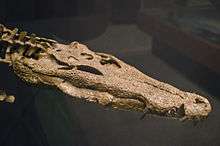Borealosuchus
| Borealosuchus Temporal range: Late Cretaceous–Eocene | |
|---|---|
 | |
| Skeleton of B. wilsoni in the Field Museum of Natural History | |
| Scientific classification | |
| Kingdom: | Animalia |
| Phylum: | Chordata |
| Class: | Reptilia |
| Superorder: | Crocodylomorpha |
| Order: | Crocodilia |
| Genus: | †Borealosuchus Brochu, 1997 |
| Species | |
| |
Borealosuchus (meaning "boreal crocodile") is an extinct genus of crocodylians that lived from the Late Cretaceous to the Eocene in North America. It was named by Chris Brochu in 1997 for several species that had been assigned to Leidyosuchus. The species assigned to it are: B. sternbergii, the type species, from the Maastrichtian (Late Cretaceous) of Colorado, Montana, North Dakota, South Dakota, and Wyoming; B. acutidentatus, from the Paleocene of Saskatchewan; B. formidabilis, from the late Santonian and Campanian of North Carolina, and Paleocene of North Dakota and Wyoming;[1] B. griffithi, from the Paleocene of Alberta;[2] and B. wilsoni, from the Eocene of Wyoming.[1] B. formidabilis is particularly well-known, represented by the remains of many individuals from the Wannagan Creek site in North Dakota.[3]
Borealosuchus was a mid-sized crocodylian; B. acutidentatus reached up to 2.8 metres (9.2 ft) in length with a 36 centimetres (14 in) skull.[4]
Classification

Species
Six species of Borealosuchus are currently recognized. In order of their naming, they are B. sternbergii, B. acutidentatus, B. wilsoni, B. formidabilis, B. griffithi, and B. threeensis. Four of these species (B. sternbergi, B. acutidentatus, B. wilsoni, and B. formidabilis) were originally named as species of Leidyosuchus.
A sixth species of Borealosuchus, B. threeensis, was named in 2012. Fossils of this species were found in the Inversand Company Marl Pit of Gloucester County, New Jersey. The specific name is a reference to Exit 3 of the New Jersey Turnpike, which is the closest highway exit to the type locality. The authors of the paper describing B. threeensis noted that the name is "in reference to a question every New Jersey resident encounters when traveling: 'Oh, you’re from New Jersey? Which exit?'".[5]
Phylogeny
According to Brochu et al. (2012) most phylogenetic analyses recovered Borealosuchus as a crocodylian more closely related to the clade Brevirostres than to Gavialoidea;[5] a few recovered it as more closely related to gavialoids[6] or as a basal eusuchian not belonging to Crocodylia.[7] According to Brochu and coauthors' (2012) own analysis, all three hypotheses are equally parsimonious.[5]

Below is a cladogram from Brochu et al. (2012) showing the phylogenetic relationships of Borealosuchus species:[5]
| Crocodylia |
| ||||||||||||||||||||||||||||||||||||||||||||||||
| |
References
- 1 2 Brochu, C.A. (1997). "A review of "Leidyosuchus" (Crocodyliformes, Eusuchia) from the Cretaceous through Eocene of North America". Journal of Vertebrate Paleontology. 17 (4): 679–697. doi:10.1080/02724634.1997.10011017.
- ↑ Wu, X-C.; Brinkman, D.B.; Fox, R.C. (2001). "A new crocodylian (Archosauria) from the basal Paleocene of the Red Deer River Valley, southern Alberta". Canadian Journal of Earth Sciences. 38 (12): 1689–1704. doi:10.1139/cjes-38-12-1689.
- ↑ Erickson, Bruce R. (1976). Osteology of the Early Eusuchian Crocodile Leidyosuchus formidabilis, sp. nov. The Science Museum of Minnesota St. Paul, Minnesota Monograph 2, Paleontology. St. Paul: The Science Museum of Minnesota. pp. 1–61.
- ↑ http://paleopedia.free.fr/croco_eusuchia.html
- 1 2 3 4 Brochu, C.A.; Parris, D.C.; Grandstaff, B.S.; Denton, R.K. Jr.; Gallagher, W.B. (2012). "A new species of Borealosuchus (Crocodyliformes, Eusuchia) from the Late Cretaceous–early Paleogene of New Jersey". Journal of Vertebrate Paleontology. 32 (1): 105–116. doi:10.1080/02724634.2012.633585.
- ↑ Eduardo Puértolas, José I. Canudo and Penélope Cruzado-Caballero (2011). "A New Crocodylian from the Late Maastrichtian of Spain: Implications for the Initial Radiation of Crocodyloids". PLoS ONE. 6 (6): e20011. doi:10.1371/journal.pone.0020011. PMC 3110596
 . PMID 21687705.
. PMID 21687705. - ↑ Diego Pol, Alan H. Turner, Mark A. Norell (2009). "Morphology of the late Cretaceous crocodylomorph Shamosuchus djadochtaensis and a discussion of neosuchian phylogeny as related to the origin of Eusuchia". Bulletin of the American Museum of Natural History. 324: 1–103. hdl:2246/5977.